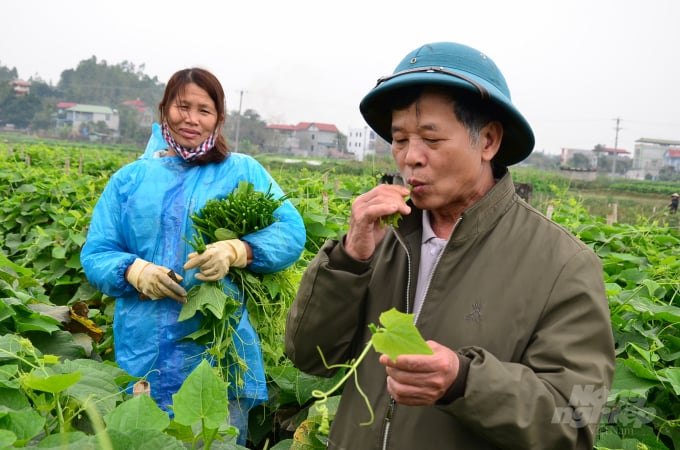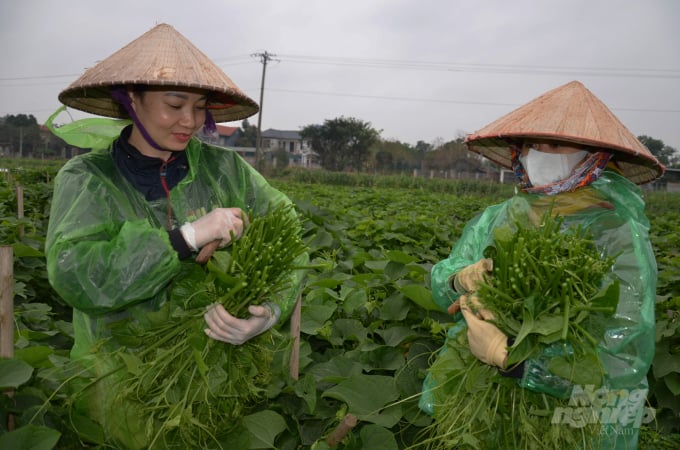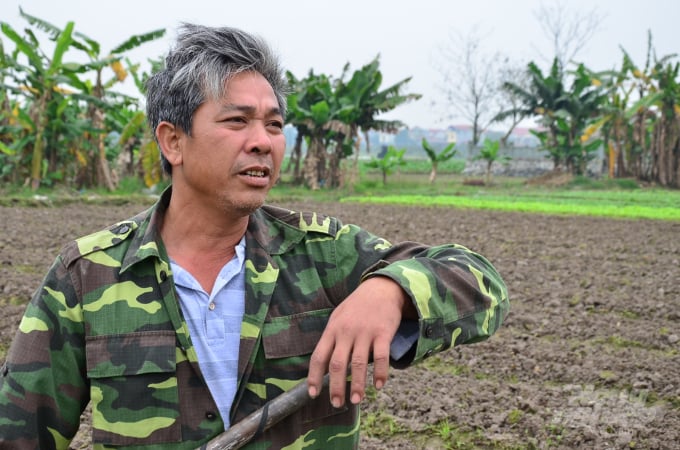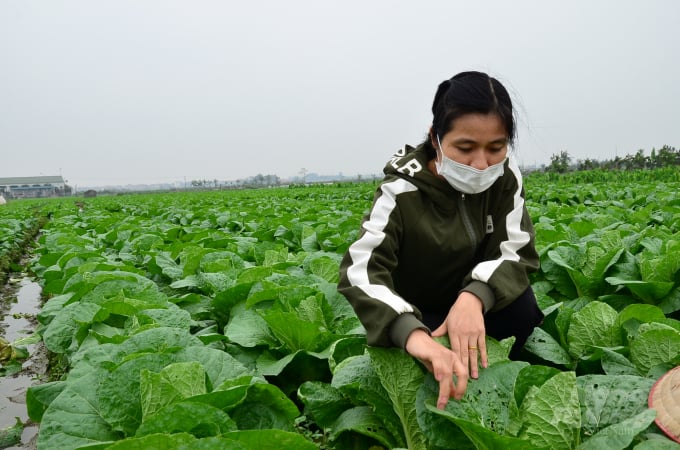May 24, 2025 | 16:26 GMT +7
May 24, 2025 | 16:26 GMT +7
Hotline: 0913.378.918
May 24, 2025 | 16:26 GMT +7
Hotline: 0913.378.918

Mr. Tran Quang Than, Head of Dong Thanh village, munching some chayote tops. Photo: Duong Dinh Tuong.
It has become a habit: Every time he goes to the field, Mr. Tran Quang Than, Head of Dong Thanh village, would snap 1 - 2 tops of chayote and put it in his mouth, munching slowly to feel the fresh and sweet taste in the tip of the tongue.
“Dong Thanh village has a total area of 16.5 ha of chayote. The locals have planted them since 2004. In the past, the people did not know the right technique, the production was fragmented, so there were also many pests and diseases. We used to spray chemical drugs three times just in the first month of planting.”
During the first time introducing the VietGAP process to the people, all are from Thanh Ha Vegetable Cooperative, but the difficulties are different from one member to another. Some households appeared to be ignorant, keep spouting things like: "My fields, my pesticides, so I spray as I wish!” But then, seeing other households following suit and being able to sell the product at a higher price, those families also wanted to join in.
To manage the quality, the cooperative organizes cross-supervision, one house supervises the other, whenever there is an abnormal phenomenon, it will be brought out to the joint group or reported to the village head.
Although they all have made a commitment to not use chemical pesticides, some households still sometimes secretly used herbicides on the edge of the field. The village convention stipulated a fine of VND 500,000/time to herbicide spraying, but it was still not as fearsome as being called out at the village conference, giving a warning, and blushing with embarrassment.
According to Mr. Than, households had to store compost manure a few months before sowing. Those who have cows would use cow manure, but if not, chicken manure is mainly the way. The fertilizing ratio is 1.5 tons /1,000m2, and the cost may go up to VND 1.5 million, but thanks to that, the plant is healthy right from the beginning and doesn't need to be sprayed.
Although biopesticides lead slowly, do not kill pests and diseases immediately like chemical drugs, they keep the plant clean and away from many natural enemies, from visible ones such as frogs, toads, and bees to invisible microorganisms.
“Therefore, even though they may not be supported in the future, the locals still look to buy microbial fertilizers and biopesticide, because, you see, the benefits are that obvious! In fact, compared to the level of care and investment, if the locals are three parts, the province’s support is only one part,” said Mr. Than.

Harvesting chayote in Dong Thanh village. Photo: Duong Dinh Tuong.
According to Ms. Nguyen Viet Xuan, Deputy Director of Vinh Phuc Sub-Department of Crop Production and Plant Protection, the unit has recently strengthened pesticide management, limiting contraband and off-list goods.
As in 2021, the unit coordinated with the market management agencies to conduct unscheduled inspections at pesticide trading establishments and discovered two points in Vinh Tuong district selling 134 smuggled Chinese rat poisons, resulting in a VND 3 million fine, also the material evidence was confiscated and destroyed.
In addition to preventing smuggled and banned pesticides, the unit also regularly recommends the use of biopesticides through farming models or right at the seed structure introduction stage through programs such as IPM, ICM, organic agriculture, and VietGAP.
In the fields of Van Hoi commune (Tam Duong, Vinh Phuc), I saw thousands of tiny huts growing at the top of each field. It was so strange to me that I had to come to Ms. Duong Thi Quynh Lien for answer, as she is the Director of Van Hoi Green Safe Vegetable Cooperative.
“Those are the compost houses of the Q-cert Project built in 2004. The province has eight vegetable growing sites that received the same investment, however people used to forsake it in the past. Thankfully the huts are now utilized to their maximum capacity. Some houses even spend their own money to build more,” Ms. Lien replied.
Mr. Nguyen Van Hung has one acre of land growing vegetables. He shared that in the past he had to put on his pesticide bottle and go to spray once per day: "It’s common that every vegetable needs to be sprayed upon growing. Now the situation seems to be better since we have less poisonous biopesticide. I have switched to using biopesticide for a few years, but it depends on the weather, like there was a severe epidemic last year, I have to spray every day but the pesticide didn't help much."
The cooperative members took a fairly heavy blow, with 12.5 ha of vegetable in particular and 80 ha in the commune in general damaged.

Mr. Nguyen Van Hung: "To be honest, I also used Chinese pesticide 2-3 times 3 years ago. After I finished spraying, I felt very tired. My head hurt. And I felt dizzy, didn’t even care to touch the rice bowl". Photo: Duong Dinh Tuong.
Biopesticides, with the disease-causing mechanism that makes pests weaken and die, were not attractive to the local people at first.
Only after Vinh Phuc had the policy to support microbiological fertilizers and biopesticide along with training programs from the Agricultural Extension Center, the Sub-Department of Crop Production and Plant Protection, have people become more aware and reduce the amount of chemical pesticides used.

Ms. Duong Thi Quynh Lien, Director of the Van Hoi Green Safe Vegetable Cooperative, checking for pests and diseases on vegetables. Photo: Duong Dinh Tuong.
Mr. Nguyen Hoang Duong, Director of Vinh Phuc Agricultural Extension Center, said, “People were too used to spraying toxic chemicals and seeing the pests die right after. Now we cannot just simply spread the word. We must have an initial support mechanism to help the locals form new habits and use biopesticide more in the future.”
Funding to support the whole program including seeds, microbiological fertilizers, natural pesticides, and biopesticide, is VND 16 billion/year: Leafy greens receive 50%support of microbiological fertilizers, 50% natural pesticides and biopesticide; fruit vegetables receive 50% support of seeds, 50% microbial fertilizers, 50% natural pesticides and biopesticide.

Mr. Nguyen Hoang Duong, Director of Vinh Phuc Agricultural Extension Center. Photo: Duong Dinh Tuong.
“The higher-ups have only directed to reduce the amount of chemical fertilizers in recent times after witnessing a sharp increase in fertilizer price, but Vinh Phuc has been doing it for several years now. We put probiotics to treat the waste of 70% of chickens, 50% of pigs, and 10% of cattle herds into organic fertilizer for use or for sale.”
When the local authority provides support in terms of microbiological fertilizers for vegetable growing areas, all old and damaged leaves once used to be collected and discarded now can be plowed down to become a new source of nutrition because the soil already contains microorganisms to turn them into organic fertilizer.
As for the support of probiotics to process rice straw into fertilizer, Vinh Phuc has issued a plan to implement in 5,000 ha per year. The model Vinh Phuc piloted in 2021 has borne fruit, reducing the amount of nitrogen used by 20% from the first crop. They predict that in the second crop this year the amount of phosphorus will also be reduced.
Translated by Samuel Pham

(VAN) The People's Committee of Tra Vinh province has approved an adjustment to the investment policy for the Green Hydrogen Plant project, increasing its area to approximately 52.76 hectares.
![Reducing emissions from rice fields: [2] Farmers’ commitment to the soil](https://t.ex-cdn.com/nongnghiepmoitruong.vn/608w/files/news/2025/05/05/dsc08881jpg-nongnghiep-140632.jpg)
(VAN) Clean rice cultivation model in Thuong Tan commune, Bac Tan Uyen district, is assisting local residents in achieving sustainable agriculture by substantially reducing costs, increasing productivity, and protecting the environment.

(VAN) At the conference to disseminate Resolution No. 68, AgriS introduced its digital agricultural ecosystem and reaffirmed its commitment to accompanying the Government in promoting private sector development and sustainable agriculture.

(VAN) 'Blue Ocean - Blue Foods' initiative is designed to restore marine ecosystems and establish sustainable livelihoods for local communities by cultivating a minimum of 1,000 hectares of cottonii seaweed in the first three years.
/2025/05/21/4642-3-112707_603.jpg)
(VAN) The V-SCOPE project has made direct contributions to three out of six pillars of the Comprehensive Strategic Partnership between Vietnam and Australia.

(VAN) Facing the threat of rabies spreading to the community, Gia Lai province urgently carries out measures to vaccinate dogs and cats on a large scale.

(VAN) Disease-free livestock farming not only protects livestock herds but also stabilizes production and livelihoods for many farmers in Tuyen Quang.